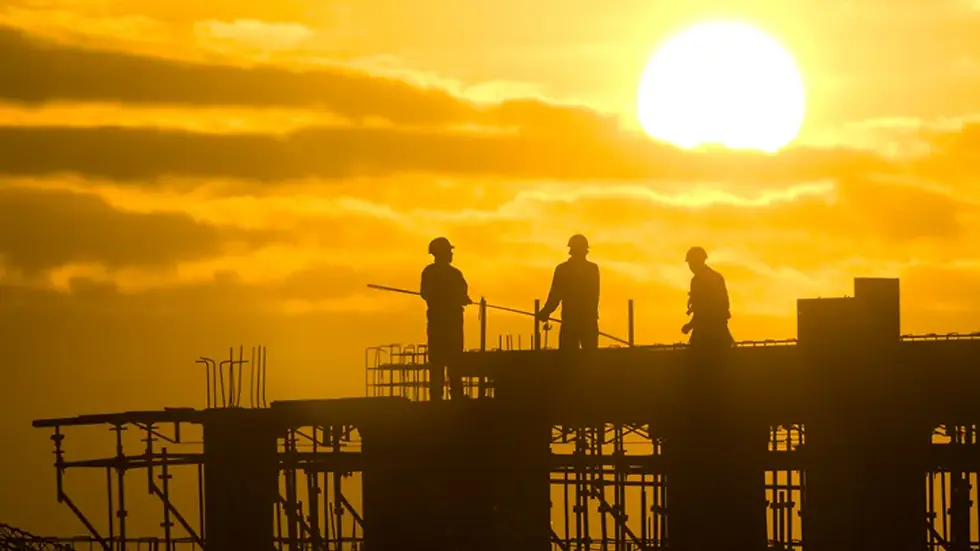Nation’s Cranes Officially on Strike as Construction Spending Drops, Blame High Interest Rates and Existential Dread
- An Industry Insider

- Jun 12
- 4 min read

In a dramatic turn of events not seen since the Great Recession or the invention of the circular saw, the American construction industry collectively muttered “screw this” in April, as construction spending declined by a nail-splitting 0.4%, according to data released June 2 by the U.S. Census Bureau. The cranes? Idle. The backhoes? Sulking. The foremen? Now life coaches.
The news sent shockwaves through job sites nationwide, triggering a cascade of confused subcontractors, laid-off laborers, and one guy in a neon vest who insists he's “just here for the porta-potty.”
According to Anirban Basu, chief economist and part-time emotional support guru at Associated Builders and Contractors (ABC), “Construction spending slipped in April as headwinds like trade policy uncertainty, high interest rates, and the sheer crushing weight of economic dread continued to batter industrywide momentum.”
High Interest, Low Interest in Building
Cranes Officially on Strike as Construction Spending Drops - The construction downturn—described by one drywall finisher as “the economic equivalent of forgetting to measure twice and cutting once”—has been attributed to a variety of issues, including the Federal Reserve’s ongoing war on happiness via interest rate hikes.
“We tried building a subdivision,” said Rick “Rafter Jesus” Maloney, a general contractor in central Ohio. “But by the time we framed the second house, the financing had matured, rates climbed another 1.2%, and my customer had been eaten by a raccoon while filling out the loan paperwork.”
Tariffs: Now With Extra Confusion
If the lending environment wasn’t murky enough, new tariffs on imported construction materials have turned procurement into a geopolitical Sudoku puzzle. Contractors now report sourcing steel from underground bartering rings and bribing Canadian lumberjacks with maple syrup just to secure delivery.
“Nearly 22% of contractors reported tariff-related project delays or cancellations in April,” Basu continued, while visibly fighting the urge to crawl under the conference table. “We thought relaxing some import taxes in May would help, but instead, it created a Schrödinger’s Supply Chain—where materials both exist and don’t, depending on which port your shipment got ‘misplaced’ in.”
Crane Operators Seek Emotional Support Animals
Perhaps the hardest hit are the nation’s crane operators, many of whom are reportedly suffering from “altitude-based existentialism.” Sources tell The Onion that hundreds of cranes have entered self-imposed lockdowns at job sites across the country, refusing to lower their loads or respond to catcalls from earthbound laborers.
“Look, you try holding 14 tons of HVAC ductwork midair while your 401k vanishes faster than your ex-wife’s alimony check,” said Chuck McGraw, a third-generation crane operator now moonlighting as a TikTok tarot reader. “We used to build skyscrapers. Now? We’re lucky if someone’s willing to finance a strip mall with two vape shops and a mattress outlet.”
Non-Residential Construction: A Slow, Pained Wheeze
While non-residential construction posted a nominal 2.8% year-over-year increase, private non-residential only crawled up by 1%, which economists say is the statistical equivalent of a cold cup of coffee. The Associated General Contractors (AGC) described the rise as “technically not zero,” which is about the nicest thing anyone’s said about commercial real estate since 2022.
Ken Simonson, chief economist for AGC, issued a press release from a dimly lit utility closet, stating: “Ever-changing announcements about tariffs on key construction inputs, along with retaliatory measures by U.S. trading partners, are making owners hesitant to commit to new projects. At this point, we’re basically telling developers to spin a wheel and pray it lands on ‘mildly profitable.’”
Residential Spending Down 0.9%, Up From “Why Even Bother”
The residential sector didn’t fare much better, declining 0.9% in April. Millennials and Gen Z—most of whom can’t afford to own property unless it’s inside The Sims—remain unimpressed.
“We had one guy try to build a house, but his preapproval evaporated after the appraisal,” said Abby Torres, a loan officer turned barista. “Now he just comes in every day, orders a sad latte, and sketches tiny porches in the foam.”
Real estate developers are reportedly holding seances to contact the spirit of 2016, hoping to conjure a return to simpler times—when people could build homes without needing a blood sacrifice and three co-signers.
Construction Workers Form Support Group, Host Weekly Bonfires
In response to the economic stagnation, construction workers across the country have formed “Builders Anonymous” groups, where they gather in abandoned cul-de-sacs to share ghost stories about permits that were once processed in under six months.
“I just want to hammer something, man,” wept one journeyman carpenter while roasting a nail gun over a fire made from expired blueprints. “We used to build America. Now we build IKEA shelves for side hustles.”
Government Offers Solution: Shrug Emoji
Inquiries to the U.S. Department of Commerce were met with a looping GIF of a confused bureaucrat spinning in a chair. When pressed for comment, an unnamed official stated: “Well, if people don’t want to build right now, maybe they could do something more affordable—like start a podcast or become influencers for spirit-level brands.”
The Future: Dirt Lots and Vague Optimism
Despite the bleak figures, some analysts maintain a brave face, pointing out that construction is a cyclical industry and “you can only dig yourself so deep before you hit a pipe and get fined by the city.”
In the meantime, the nation’s bulldozers have returned to grazing in open fields, electricians are contemplating philosophy degrees, and one enterprising roofer has launched a meditation app called "Nail & Exhale."
The message from the construction world is clear: If something doesn’t change soon—if lending remains tight, tariffs stay weird, and trust in the system keeps plummeting—then America may be stuck with more half-finished strip malls and vaporware condos than it knows what to do with.
But hey, at least we’ll have a record number of construction cones standing vigil over our economic anxiety.
_edited.jpg)





Comments